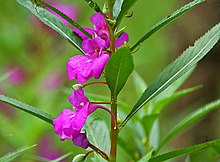Asterids
| Asterids | |
|---|---|

| |
| Impatiens balsamina from Ericales | |
| Scientific classification | |
| Kingdom: | Plantae |
| Clade: | Tracheophytes |
| Clade: | Angiosperms |
| Clade: | Eudicots |
| Clade: | Superasterids |
| Clade: | Asterids |
| Clades | |

In the APG II system (2003) for the classification of flowering plants, the name asterids denotes a clade (a monophyletic group).[1] Common examples include the forget-me-nots, nightshades, potatoes, eggplants, tomatoes, peppers, tobacco, petunias, morning glory, sweet potato, coffee, lavender, lilac, olive, jasmine, honeysuckle, ash tree, teak, snapdragon, sesame, psyllium, garden sage, and a number of table herbs such as mint, basil, and rosemary.
Most of the taxa belonging to this clade had been referred to the Asteridae in the Cronquist system (1981) and to the Sympetalae in earlier systems.[citation needed] The name asterids (not necessarily capitalised) resembles the earlier botanical name but is intended to be the name of a clade rather than a formal ranked name, in the sense of the ICBN. This clade is one of the two most speciose groups of eudicots, the other being the rosids. It consists of:[1]
- clade asterids:
- clade euasterids I
- family Boraginaceae
- family Icacinaceae
- family Oncothecaceae
- family Vahliaceae
- order Garryales
- order Solanales
- order Gentianales
- order Lamiales
- clade euasterids II
- family Bruniaceae
- family Columelliaceae (+ family Desfontainiaceae)
- family Eremosynaceae
- family Escalloniaceae (+ family Tribelaceae)
- family Paracryphiaceae (+ families Sphenostemonaceae and Quintiniaceae)
- family Polyosmaceae
- order Aquifoliales
- order Apiales
- order Dipsacales
- order Asterales
Note: “ + ....” = optional as a segregate of the preceding family.
APG III
Genetic analysis carried out after APG II maintains that the sister to all other Asterids are the Cornales. A second order that split from the base of the Asterids are the Ericales. The remaining orders cluster into two clades, the Lamiids and the Campanulids. The structure of both of these clades has changed in APG III. The phylogenetic tree presented hereafter has been proposed by the APG III-project.[2]
| Asterid clade |
| ||||||||||||||||||
References
- ^ a b Angiosperm Phylogeny Group (2003). "An update of the Angiosperm Phylogeny Group classification for the orders and families of flowering plants: APG II" (PDF). Botanical Journal of the Linnean Society. 141 (4): 399–436. doi:10.1046/j.1095-8339.2003.t01-1-00158.x. ISSN 0024-4074.
- ^ APG III (2009). "An update of the Angiosperm Phylogeny Group classification for the orders and families of flowering plants". Botanical Journal of the Linnean Society. 161: 105–121. Retrieved 2016-02-29.
External links
- Asterids in Stevens, P. F. (2001 onwards). Angiosperm Phylogeny Website. Version 7, May 2006.
